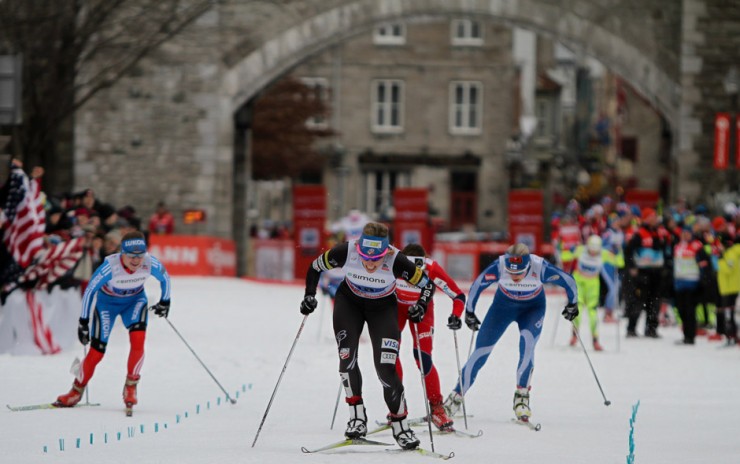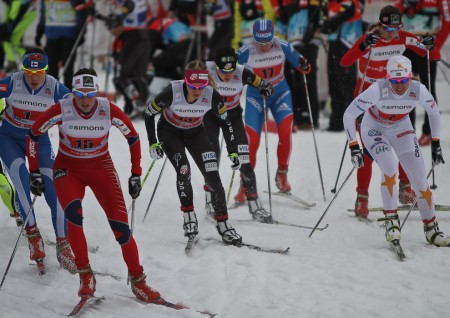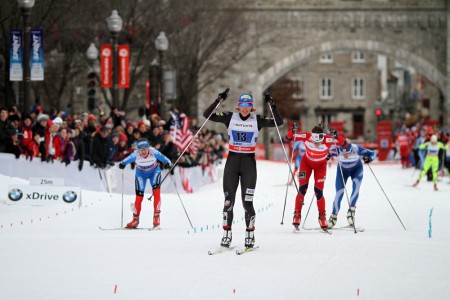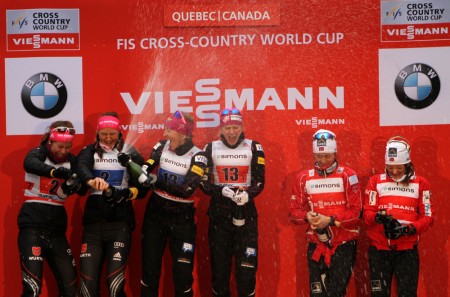
QUEBEC CITY — La Citadelle, the massive 19th century Quebec fortress overlooking the St. Lawrence, provided no shelter from a relentless U.S. attack — the firepower of Jessie Diggins and Kikkan Randall proved to be too much for both the looming battlements and the women’s World Cup field.
Racing along the base of the fortress wall, just down the street from a battery of cannons, Diggins and Randall continued to impose American rule on international cross-country ski racing.
Skiing in front of what may as well have been a home crowd, the duo notched the first U.S. victory of the season, and the first ever World Cup team sprint win.
“We’re going to party tonight!” Deborah Randall, mother of Kikkan, crowed after watching her daughter head for the top of the podium.
Coming into the first Eastern Canadian World Cup races in 27 years, the United States had to be the favorites despite strong teams from Norway, Russia, Sweden and Slovenia.
Supposedly easing into the season after recovering from a stress fracture, Randall has been exceptional in the early-going, notching two distance podiums, and helping the U.S. relay team to third in a 4x5k relay.
Her teammates have not been far behind, and with the U.S., anchored by Randall, placing second in both team sprint competitions last year, good money was on the Americans to continue breaking through.
As with all city sprints, especially those of the team variety, the key to success lay in staying out of trouble — or more simply, just staying vertical.
In Milan, Italy last year, Diggins crashed hard in the transition zone, leaving Randall with a big gap to close. That race may have been ten months ago, but the memory, of both the fall and the resulting bruises, was still fresh in the 21-year-old’s mind.
“I stayed on my feet,” she said when asked about the difference between second place in Milan and first in Quebec City.

“Basically I just wanted to make sure I did not fall and get tangled up,” she explained.
Diggins describes herself as “not the most aggressive skier,” a fact that has allowed her to be pushed around in the rough and tumble world of international ski racing.
To remedy this shortcoming has been a goal for this season, and her hard work and focus have clearly paid off.
After a strong start, Diggins held position toward the front of the pack, weathering the turbulent flow of the race without significant mishap.
On her last leg, with just one lap left on the two-lap course, Diggins made her move. From fourth, she maneuvered into second behind Norwegian Celine Brun-Lie, and then, along the backstretch before the final turn into tag zone, she took over the lead, creating a small gap.
“Man, when she decided she wanted to turn on the gas, she just flipped a switch and turned on the gas,” U.S. Ski Team (USST) head coach Chris Grover said after the race.
“I was really impressed by Jessie,” he continued. “She skied so clean.”
Grover knows all too well how fortunes can change in a split second, pointing specifically to Randall’s crash in the World Championship sprint in Oslo two years ago, a race she was favored to win — coming through unscathed is no small feat.
“We have been on both sides…We definitely live by the sword, die by the sword,” he said.
Diggins had a close call, tangling briefly with Swede Magdalena Pajala, who went down and ended up out of contention.
All was well, however, when she came driving around the final corner with three meters on the chasing Norwegians. While Randall had yet to be tested in a skate sprint this season, her clear strength in the semis, and her penchant for improving over the course of the day, made a siege of the stone bulwarks more likely to succeed than any effort to get by.
Randall’s preferred strategy is to “sit in behind someone and make a big move at some point,” but when handed first place, she focused on the many positives of the situation.

“You get to ski your line. You get to control the pace. And the way this course skied, where it was difficult to pass, it was a good position to be in,” she said.
Confident in her fitness, she kept the pace high, not wanting her competition cruising behind.
She entered the gradual uphill of the homestretch still in front, and with the first step on her opponents and choice of line, she was never threatened for the win.
“It is a feeling I have never felt before,” Gus Kaeding, SMS T2 coach, who is on-hand to work with the team, said of watching the Americans win the race.
“Once I saw she had the lead, I thought she had a pretty good chance, but you know there is always thinking ‘what if, what if,’ and then that good feeling, just kind of want it, and then she is there [across the line],” Kaeding said.
Grover was more confident, despite his admission that watching the race was “nerve wracking.”
When he saw Randall receive the tag in front he said he “felt she would win.”
He knew she would go out and control the pace, but in her first freestyle sprint of the year, “then the question is how fast can she go when it really comes down to it. It was cool to see there was yet another gear there today.”
While Randall half raised her arms in modest celebration as she crossed the line, the battle for second played out behind.
Entering the final stretch, four other teams remained in contention — Norway, Germany, Russia II, and Finland. The Norwegians held the edge, but Maiken Caspersen Falla, second to Randall in the Sprint Cup last year, lost her balance, opening the door for a surprising German team.
“We are very surprised. We did not expect to be on the podium, but we are so happy,” Hanna Kolb, the scramble skier for the Germans said after the race.
The excitement and surprise makes sense considering the result marked the first podium appearance for both Kolb and teammate Denise Herrmann.
Falla meanwhile was disappointed to bring her team home in third. Overall she said she was pleased with her race, but was hoping to close out better.
“I lost the control of my skis, but it was my own fault and hopefully I will be better tomorrow,” she said.

While hard to imagine, the day could have been even better for the Americans. United States II, running Ida Sargent and Holly Brooks, stayed in the fight for the early part of final, but any hopes for a top finish came to a crashing end when Sargent went down on the first lap of her second leg.
Coming out of a fast downhill corner, Sargent and Norwegian Kari Gjeitnes came together, and both went down, Gjeitness slamming to the ground on her rear and Sargent on her face.
The American was back on her feet, but well off the pack, and struggling to ski smoothly with her Pilot binding disengaged. The binding caused her to go down a second time, and any hope of a comeback was dashed.
Brooks continued to ski strong, even posting the fastest leg time her second time on course.
“It’s always hard to lose the pack because you’re kind of in no-man’s land unless there’s a big crash,” Brooks said.
But she said she was “feeling great” and that “if nothing else this bodes well for tomorrow.”
“I had hoped that we could put two teams in the top five, and barring crashes, we could’ve done that today,” Brooks said.

Nat Herz and Alex Matthews contributed reporting



